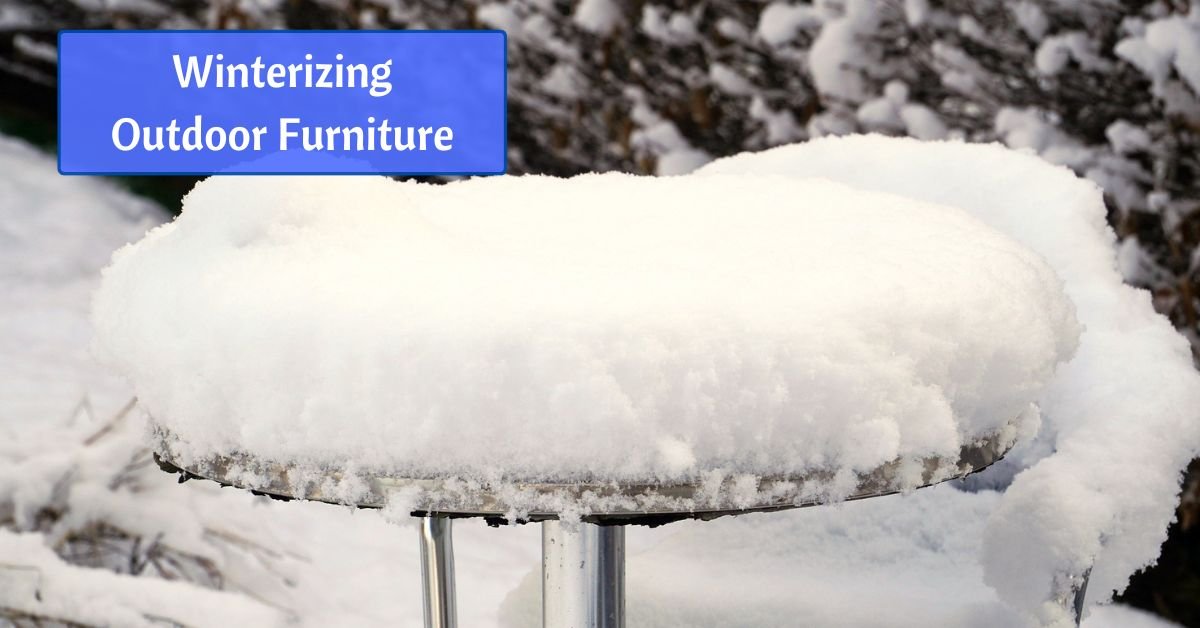When winter approaches, it’s crucial to give your outdoor furniture the attention it needs to survive the cold, snowy, and windy months ahead. Proper care and protection can extend the life of your outdoor furnishings and ensure they remain in good condition for next spring.
In this guide, we’ll take you through the steps to care for and protect your outdoor furniture.
Cleaning and Inspection
Before preparing your outdoor furniture for winter, start by giving it a thorough cleaning and inspection.
Remove dirt, leaves, and debris from your furniture. Use a brush or a vacuum cleaner to get into crevices and cushions.
As you clean, examine each piece for signs of wear, rust, or damage. Look for loose screws, peeling paint, or any issues that need attention. It’s best to make repairs now since bad weather can worsen what seems like a minor issue in the fall.
Wood Furniture
Wooden outdoor furniture like teak or cedar requires special care to withstand winter conditions. Here are the basics:
- Clean and Dry: Clean the wood with a mild soap and water solution. Allow it to dry completely.
- Apply Protective Finish: If your furniture has a natural finish, consider applying a protective sealant or outdoor wood oil to prevent moisture penetration.
- Store Indoors: If possible, store wooden furniture indoors or in a dry, sheltered area to protect it from snow and moisture.
Guide to restoring wooden furniture
Metal Furniture
Metal outdoor furniture, such as aluminum or wrought iron, can be resilient but still needs care if you want it to last from season to season.
- Clean and Dry: Wash the metal surfaces with soapy water, rinse, and ensure they are completely dry.
- Remove Rust and Touch Up: Where necessary, scrub away any rust spots with a wire brush or sandpaper. Apply a rust-resistant primer and touch-up paint.
- Add a Protective Coating: Apply a clear outdoor metal protectant to maintain the finish and guard against rust.
Guide to restoring metal furniture
Wicker and Rattan Furniture
Wicker and rattan furniture, while visually appealing, can be particularly sensitive to winter moisture.
- Clean and Dry: Clean these pieces with a brush and soapy water. Rinse thoroughly and allow them to dry completely.
- Store Indoors or Covered: Whenever possible, store wicker and rattan furniture indoors or under a patio cover to protect it from snow and moisture.
Plastic Furniture
Plastic outdoor furniture is low-maintenance but still needs some care:
- Clean: Wash plastic furniture with soapy water, rinse, and let it dry completely.
- Stack or Store: Stack or store plastic pieces in a dry area if possible. Otherwise, cover them with waterproof furniture covers.
Fabric and Cushions
Outdoor cushions and fabric need proper care to prevent mold and mildew growth. And you don’t want to have to deal with that when you’re ready to enjoy the deck or patio again!
- Clean and Dry: Remove cushion covers and wash them following manufacturer instructions. Allow them to dry thoroughly.
- Storage: Store cushions indoors or in a dry, covered area. If storage space is limited, consider using weatherproof cushion storage bags.
Storage
Storing your outdoor furniture during winter is always a good idea. If you’re able to keep it in the garage or another sheltered area, it will be spared the bulk of the harmful effects of freezing temperatures and blustery winds. High winds can also pick up lighter pieces and crash them against your house, doing further damage.
So our first recommendation is to find an indoor place – or at least a sheltered outdoor area – for your furniture. However, some outdoor furniture may be too heavy to move or you may lack the space for storage. So here are some other suggestions when you must leave it outdoors.
Furniture Covers
Invest in high-quality, waterproof furniture covers that fit your pieces snugly. These covers protect against snow, rain, and dirt and can significantly extend the life of your furniture. Be sure to secure the covers to prevent wind from blowing them off.
Elevate Furniture
If you’re leaving furniture outdoors, elevate it slightly to prevent it from sitting directly on wet ground or snow, which can lead to moisture damage. You can use furniture risers or even bricks or cinder blocks to achieve this.
Heavy or Oversized Furniture
You’ll also want to cover up and secure any pieces that have to stay outside.
- Securely Cover: Use large, heavy-duty furniture covers to protect your pieces. Ensure they are anchored in place to withstand wind.
- Tie Down: Secure your furniture to prevent it from shifting or toppling during strong winds. Heavy-duty straps or bungee cords work well for this purpose.
Regular Check-Ins
Throughout the winter, periodically check your outdoor furniture for any signs of damage or moisture buildup. Remove snow or ice accumulation promptly, and ensure the covers are still in place and secure.
Following these steps will help ensure your furniture remains in good condition during the winter months. Whether you have the luxury of storing it indoors or must protect it outdoors, the effort you put into winterizing your outdoor furniture will pay off when the warmer seasons return. You’ll be grateful that you took the time to prepare!









